Just over a fortnight before the roof falls in on the US, another institution prepares itself for another phase in its long, checkered and legendary existence. On this Monday afternoon, the Rolling Stones have taken over the Four Seasons hotel in Boston in order to talk about their new album, Blue & Lonesome, and to prepare for the night’s show.
It’s the last of a few American dates including Desert Trip, the California festival that saw them join a bill completed by Paul McCartney, Bob Dylan, Neil Young, Roger Waters and the Who (earning it the nickname Oldchella). Then came two dates in Las Vegas – one of which was cancelled after the desert dust gave Mick Jagger laryngitis. However, tickets are not available for Boston.
“It’s a private show,” Charlie Watts tells me. Is it for someone’s birthday? “They’re usually big corporations,” Watts shrugs. “Elton does loads of them. Elton John at the old piano – he’s perfect for that but we’re really not very good at these things. I mean, people like it, but we’re more used to the huge stage.”
It later turns out that the Stones are playing for Robert Kraft, owner of American football team the New England Patriots, in a tent pitched at the Gillette stadium, rather than the hotel ballroom I’m imagining. “I love playing in clubs, actually,” Charlie Watts says. “These thing aren’t like that, they’re functions. To be honest, it’s what I started out playing.”
As well as finding themselves a band for hire playing parties again – albeit for a businessman worth $5bn, paying them a rumoured $3m – the Rolling Stones are returning to their roots in another way. This week they release Blue & Lonesome, comprising cover versions of old blues deep cuts, mainly by Chicago artists (four by Little Walter and two by Howlin’ Wolf). Twelve tracks long, it’s the first Rolling Stones album to contain more songs by other people than any since their self-titled debut from 1964, the days when they were essentially a blues covers band (their name itself is taken from a blues song, Rollin’ Stone by Muddy Waters).
The way Keith Richards tells it, the album happened pretty much by accident, when the Stones gathered in British Grove Studios in London last December to work on some new material. The sound wasn’t gelling, so Richards told the band to play Little Walter’s Blue and Lonesome. “We cut that, we listened to it back and suddenly the sound is there. Mick turns round and says, ‘I wanna do this Howlin’ Wolf song,’ and then he says, ‘And I’d like to do this Lightnin’ Slim,’ and now I’ve got the man on a roll. When you’ve got the lead man calling the shots and saying, “I want to do that, I want to do this,’ keep the tape rolling.” And they do record on tape, Richards says. “This is not digital crap.”
The band recorded the bulk of the songs in two days. “Maybe Ian Stewart was sending a message from above,” Richards says, referring to the Rolling Stones’ sixth member, kicked out of the band for not having the right look, but who stuck around as their tour manager and pianist until his death in 1985. “It’s almost like getting something off your chest that had been there for a long time. I’m looking forward to volume two already.”
Jagger took more convincing. “At first Mick was a little bit, ‘The blues album? Oh no,’” Richards says. “I said, ‘On this you shine, man. This is Mick Jagger at his fucking best!’” And indeed, Blue & Lonesome has a purposeful swagger that cuts through the showbiz to reveal the Stones as musicians and fans reunited with songs they have known, as Richards says, “since babyhood”.
Jagger isn’t talking – he’s saving his voice – so I interview the other Stones one by one. I meet Watts and Richards in two empty hotel conference rooms; speaking to Ronnie Wood is a cosier experience up in his suite of rooms on the sixth floor. His baby twins Gracie and Alice wriggle in the arms of his wife, Sally Humphreys, while Wood gets stuck into an early evening drink. At 69, does he ever feel that he can’t be bothered to go onstage?

“No, it’s a delight,” says Wood, still regarded as the band’s new boy (he joined in 1975). “As long as we can still do it and each of us in our own departments takes care of that particular thing, as long as Mick is out there selling the song in such a good way, that’s great.”
The world is finally coming to terms with the fact that, like their bluesmen heroes, the Rolling Stones have no intention of giving up performing, more than 50 years after they started. “Howlin’ Wolf almost died on stage, plugged into his kidney machine, so there’s no reason why we wouldn’t go exactly the same way,” Wood says. “I saw John Lee Hooker not long before he died [aged 83, in 2001] and he was showing me backstage, showing off his new CD and his new white hat and his new girlfriend – he was rocking right to the end.”
Those that don’t have the same attitude leave the band. The day I interview the Stones, it’s Bill Wyman’s 80th birthday: Wood, a talented artist, has painted Wyman’s portrait and given it to him as a present. “I know – we’re quite kind sometimes, aren’t we? Even to old members,” chuckles Wood’s manager Sherry Daly, hovering nearby.
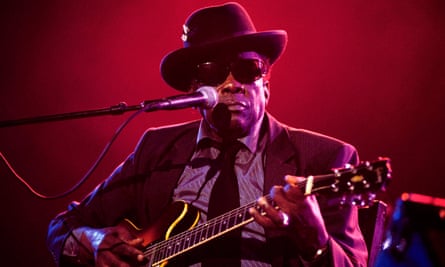
Then there are those band members who haven’t lasted the course – not just Stewart, but also Brian Jones, who founded the band and drowned in 1969, aged 27. Since Jones was the band’s blues purist, I ask Watts whether he thought of him while recording Blue & Lonesome. “Nah,” says the drummer. The Rolling Stones could never be accused of being overly sentimental.
“When I was playing the Jimmy Reed one, Little Rain, I was remembering Brian and figuring it out in 1962,” offers Richards. “The guy is not totally obliterated, but don’t forget that we have another Jones in the band now – Darryl” – their bassist, Wyman’s replacement. “And that guy can kick ass, man.”
Richards, dressed in a scarf that trails from around his head to the floor, scarlet hi-top sneakers, and a bracelet that looks as if it’s made from the locks you might use while abseiling, is at pains to disabuse me of the notion that being in the Rolling Stones aged 72 might now be a bit boring compared to their decadent peak. “I’m actually still recovering from a rock’n’roll party,” he says, lighting up a fag (of course, the Four Seasons is a non-smoking hotel). “Cats came to my room, Peter Wolf [of the J Geils Band] came to see me, Darryl Jones comes by, then we start to play some Little Richard shit, then in walks Sasha Allen [who sings back-up with the Stones] and before you know it it’s eight in the morning and I’m, ‘Guys, we’ve got to knock it off here.’ If it was on film it would be hilarious.”
With mild trepidation, I tell Richards that I recently watched a Stones-on-tour documentary – Cocksucker Blues. Made by Robert Frank, it captures the band’s 1972 tour, with scenes including Richards nodding out while watched over by a groupie, an orgy on the band’s private jet, and several lovingly detailed scenes of intravenous heroin use – all reasons why the band have kept it from general release. I think it’s a great film, I tell him. “Me too,” Richards agrees, “Frank really captured some moments.”
I hate to be bourgeois, I say, but I also found it pretty shocking. “Life on the edge,” says Richards. “The monument of the unknown junkie.” He’s referring to a section where one of the Stones’s bombed-out entourage proposes a memorial to an OD victim akin to the tomb of the unknown soldier. “It was a monument to himself I think but the way he put it across was a great idea. It’s the characters that you meet on the road – you’re not in a cocoon, you’re working with people. Danny Seymour, who’s doing the sound on there – all these cats are dead now, man.”
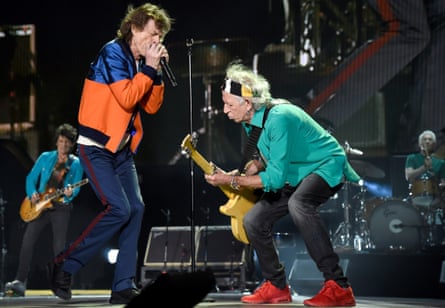
Seymour was Frank’s sidekick, credited as “Junky Soundman”: Cocksucker Blues is nothing if not gonzo. It also captures the mixture of lowlife and high society that was (and perhaps still is) unique to the Rolling Stones’ backstage ecosystem, in which Andy Warhol and Truman Capote swing by the dressing room, alongside Richards’ favoured ne’er-do-wells. “They’re wondering, ‘Is this art or what?’, I’m looking at Andy Warhol thinking, ‘Are you art or what?’” Richards splutters out his famous laugh, which sounds like 60 years’ worth of fags and drugs residue attempting to escape from his chest. “I love the Campbell’s soup can, but I really don’t think it’s the Mona Lisa.”
He isn’t too keen on the work of Roger Waters, either, who was on the bill at Desert Trip. “To me it’s got nothing to do with rock’n’roll. What if he played in daytime?” He laughs. “It’s a light show, for Christ’s sake! But that’s all right, it’s a piece of theatre. I guess what the Rolling Stones are is a little bit of theatre and a little bit of reality at the same time.”
One person the Rolling Stones do rate is Dylan; the Desert Trip shows coincided with him being awarded the Nobel prize for literature. “He kept calling me Sir Ronnie,” Wood says, “and when Charlie walked in he said, ‘And Sir Charlie, too! Everyone from England is a sir, right?’ And we said, ‘Yeah Bob, but it’s not like … it’s really good about your Nobel prize.’ And he went, ‘You think so? It’s good, huh?’ And we said, ‘You deserve it.’ And he said, ‘That’s great – thanks.’ He didn’t really know how to accept it but he thought he had done something pretty good.”
Like Coachella, Desert Trip took place on the same site again the following week. “I did notice that the next week, Bob’s standing up at the piano like Little Richard and he’s got this little flash Nudie shit going down – shit, dog, go for it,” Richards says. “Mick and I were watching Bob’s first set and it sounded good, the band was great, and I said, ‘Mick, notice – very little concession to showbusiness,’ and Mick went, ‘Yeahhh, right.’”The Rolling Stones are far more dependable than Dylan in that regard – every night you get the hits, in a recognisable rendition, with some deeper cuts alternating through the set. Watts, a bone-dry wit in a cardigan who says his preferred listening is “jazz or Radio 3”, is enjoying their late career as a festival band. “Glastonbury was the first one that I said, ‘We don’t want to do that, it’s a load of crap,’ and actually it was very nice. I’d never go to see a band in a bloody field playing – I wouldn’t go to a stadium to see a band either – but Glastonbury and the desert thing were fun.”
“The job never stops changing,” Richards says. “We were playing for 10 years without a soundsystem, that came around 1969. You used to just go up there with your amplifier, plonk, and do the best you can.”
The Rolling Stones’ most notorious gig, was also in California – Altamont, where a decision to allow the Hell’s Angels to act as security guards led to a fan, 18-year-old Meredith Hunter, being stabbed to death by an Angel in front of the stage while the Stones played. Is it true the stage was only 4ft high?
“That was about right, it was pretty low,” Richards says. The collapse of plans to play a free show, a Woodstock of the west, in San Francisco’s Golden Gate Park, then at Sears Point Raceway, which would have been a more suitable venue, led to the band choosing at short notice to play the bleak Altamont speedway in the hills, well outside San Francisco. “There were no cops there, the Angels were running the joint and I wouldn’t trust the Hell’s Angels to get me a coke – and I just mean a Coca-Cola, I don’t even mean coke!” snorts the guitarist. “But they were out of it, things got out of hand. Also in ’69 there was that angst in the air, kind of like there is now, but I don’t want to get into that because it ain’t over and it’s not my country.”
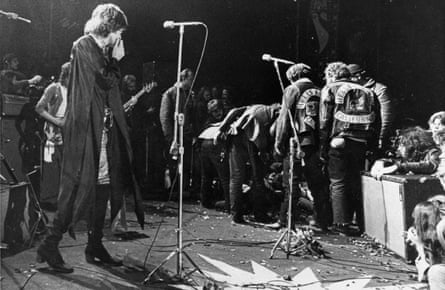
Nonetheless, says Richards, the gig often regarded as marking the end of the innocent dreams of the 60s wasn’t all bad. “I think given that there were about half a million people there, I’d say that 499,000 had a good time,” he says. “Which is not bad on the average, you know? And one man died, but a baby was born, so the same number came out as went in. If that hadn’t happened it would have been considered a Woodstock on the coast. All it takes is one sucker with a knife.”
In fact, as Joel Selvin’s book Altamont earlier this year made clear, the event was a pretty much unmitigated disaster from start to finish, as thousands upon thousands of people on bad drugs, rival groups of Angels, a lack of basic facilities and a hippie faith in good nature came together in a perfect storm of disaster. Meredith Hunter was not the only person to die at Altamont. One person trying to reach the site drowned in a drainage ditch; two more were killed when a hit-and-run driver ran them over at the side of an access road to the site.
Altamont alone would have finished off many bands, but not the Rolling Stones. Equally, death claims younger musical peers such as David Bowie and Prince, but the Stones march on. “Prince was a real shock,” says Watts. “Quite young as well.” He points out that Prince had history with the Rolling Stones, playing a disastrous support slot on their 1981 American tour.
“You know that album cover with the knickers?” He means Dirty Mind, from 1980, on which Prince wears black bikini briefs and a flasher’s mac. “Well, Mick and I both loved that album – Keith hated it – and we got him on our show. Of course, being Prince he duly went on in his knickers and our audience booed him off. Which didn’t deter me from liking him.”
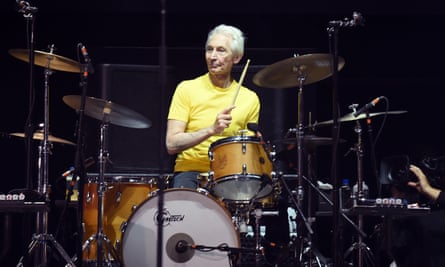
Prince’s early albums were a black American take on new wave and rock. The Rolling Stones approached music in the opposite direction: white Englishmen tackling African-American blues, as Blue & Lonesome makes crystal clear. If they were a group starting out now, trying the same thing, they would be accused of cultural appropriation, of stealing someone else’s culture.
“It’s emulating, I don’t think it’s stealing necessarily,” says Watts. “That’s all I’ve ever done. I never learned to play the drums, I used to watch Phil Seaman and listen to Max Roach or Baby Dodds or Louis Armstrong.” Seaman was white and English; the other three were black Americans.
Watts believes that coming from a specific culture is a factor: “I’m never going to play reggae as well as Sly and Robbie or the Barrett brothers” – the last being Bob Marley’s rhythm section. “They’re Jamaican, their aunties used to dance to that when they were children, you know what I mean? It’s where they come from. But you know, Ginger [Baker] is as African as any African when he plays the drums. So was Phil Seaman, actually.”
This is the kind of talk that makes hackles rise, though perhaps not so much among musicians as their defenders in the press or the academy. When the Rolling Stones actually went to Chess studios in 1964 – when Muddy Waters was doing jobs around the studio – and 1965, the bluesmen welcomed these skinny, white Englishmen with open arms.
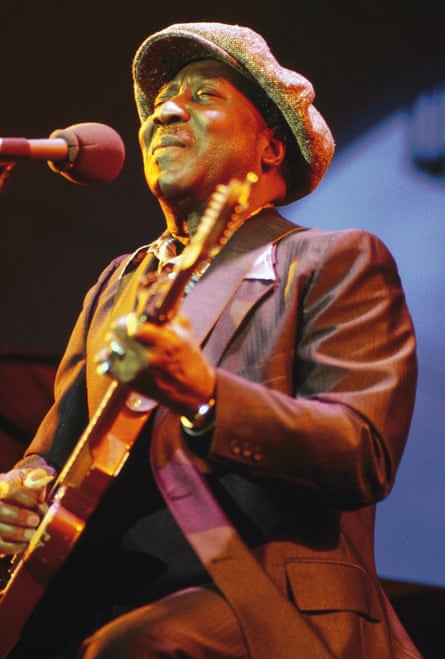
“Those blues people had a lot of heart, they reminded me of the art school crowd and my dad and mum’s drinking pals from the pubs – they were all warm people,” says Wood. “When I was up in my mum’s little council house with my first little Dansette player, I used to learn the riffs, and when you meet with these guys later on they were as much of a delight to play with. They were all a bit sad that they got ripped off, they all had that in common, but they certainly didn’t let it get them down that much.”
“If we’re playing a Muddy Waters song and it sells 10m and Muddy sells 1m, I can see that his descendants would be angry about that,” Watts says. “Even if you gave all the money back I don’t know whether the situation would be any better. All you can say is that you admire whoever it is. I mean, I owe my living to Freddie Below. I do. That’s who I copied.” The consummate blues drummer, Below’s playing drove many of the records the Stones have covered on Blue & Lonesome.
“Music’s a bit like poetry or something,” Watts continues. “Once it’s recorded it’s anyone’s. You could be an Israeli that can’t speak English and play as well as Roy Haynes [the great jazz drummer]. What they call world music on the BBC is full of that. You’re suddenly going, ‘Bloody hell, who’s that?’ and it’s some guy from Tashkent. Because they listened to the record, you know?”
Blue & Lonesome suggests that 50 years on, the Rolling Stones are in the astonishing position they are today because they also listened to some records. Yet they made plenty that were equal to – or surpassed – their inspirations. Will we ever hear more Stones originals? So Wood claims: “In 2017 we’ll shape up these news songs – we’ve got some in the can and then there’s a lot more on the back burner.”
In the meantime, the Stones corporation adapts for a new era, though Wood disputes that description. “What do they call the farmers with the little dairies – home farms?” A cottage industry? “Cottage! That was the word I was looking for. I was just talking about this cottage industry, the Rolling Stones.”
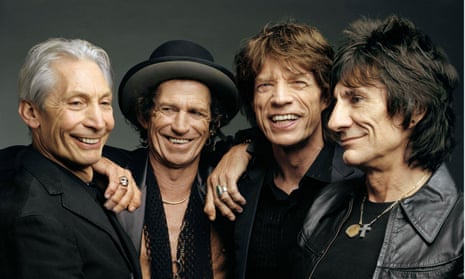
Comments (…)
Sign in or create your Guardian account to join the discussion